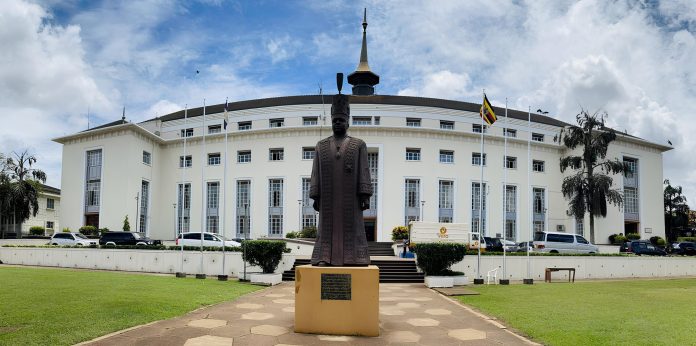The Buganda kingdom is the largest of Uganda’s traditional, medieval, and subnational kingdoms. It was established in the late 14th century along the shores of Lake Victoria and grew to become an important and powerful state during the 19th century. Geographically, the Buganda kingdom is surrounded by Lake Victoria to the south, the River Nile to the east, Lake Kyoga to the north, the River Kafu to the northwest, and the districts of Masindi, Hoima, Kibale, Kyenjojo, Isingiro, and Kiruhura to the west.
The Buganda kingdom comprises all 26 districts of Uganda’s Central Region, including the Ugandan capital city, Kampala. It is divided into 18 officially recognized counties known as “masaza”. Each county is further divided into sub-counties called gombolola, which are then divided into parishes known as Miluka (singular: muluka). These parishes consist of two villages.
The kingdom is predominantly made up of Uganda’s largest ethnic group, the Baganda, who represent 16.9% of the country’s population. The Baganda (singular: Muganda) are sometimes referred to as the “king’s men” due to their significance and the roles they play in the kingdom’s political, cultural, and social institutions.
History of Buganda kingdom

The Buganda kingdom is among several kingdoms that emerged after the fall of the Chwezi empire. It was established in the northwest part of Lake Victoria and east of Bunyoro, between Lake Kyoga and Lake Albert. The Baganda people are thought to have originated from Bantu clans that migrated from the Congo Basin, while others came from Eastern Uganda. Some clans of the Buganda kingdom are said to have originated from the Ssese Islands and settled in present-day Busiro, Mawokota, and Kyadondo.
The kingdom’s origin is not entirely clear, but various theories have been proposed. According to oral tradition, the kingdom was founded by Kabaka Kintu, whose origins are uncertain. Traditional legends suggest he came from the northeast, descended from heaven via Bunyoro. Perhaps most credibly, it’s believed he arrived in Buganda from beyond Mount Elgon, suggesting an origin in Sudan or Ethiopia. Kabaka Kintu came to power after defeating the local ruler named Bemba Musota and declared himself the head of all clans, known as Ssaabataka. He took over a house in Naggalabi Buddo, 20 km from Kampala, as a symbol of victory. This house was called Buganda, a name later transferred to the entire territory ruled by Kintu. Naggalabi Buddo remains the coronation site of the Kabaka to this day.
According to Bunyoro tradition, the founder of the Buganda kingdom was Kato Kimera, who came from Bunyoro and is believed to be a brother to Rukidi Mpuga, the founder of the Babito dynasty. It’s believed that Kato Kimera carved out Buganda from the collapsing Bunyoro-Kitara kingdom. King Kato Kimera is said to have brought with him five to six present-day clans of Buganda. After Kintu, 36 kings followed, but they all mysteriously disappeared after laying the foundation of Buganda.
In the early centuries, the kings ruled under the influence of clan heads. By the year 1700, the Buganda kingdom had gained more control over its territories. Initially, the kingdom consisted of only Busiro, Mawokota, and Kyadondo around the 15th century.
During the 16th century, Buganda started to expand its land by conquering several chiefdoms, which increased the number of provinces to 12 by 1890. The newly acquired lands were placed under chiefs chosen by the king. The Buganda army and royal tax collectors were able to quickly move to different parts of the kingdom.
By the 17th century, Buganda had grown to include Singo, Gomba, and Butambala under Kabaka Katerega, who took these areas from the Bunyoro kingdom. Under Kabaka Jjunju, Buganda expanded further to include Buddu and Kooki, which were taken from the Ankole kingdom. By the middle of the 19th century, Kabaka Mawanda had captured the counties of Bulemeezi, Kyaggwe, and Bugerere, making Buganda the largest kingdom in the interlacustrine region at that time.
In 1900, following the Buganda agreement, with the help of the British, Kabaka Muteesa brought in the lost counties of Buyaga, Bugangaizi, and Buluri as a reward for their collaboration with the British in crushing Bunyoro.
Language
The Luganda language is widely spoken in the Buganda kingdom and is the second most popular language used in Uganda, alongside English. Before Uganda gained independence in 1962, Luganda was also used as a means of instruction in schools outside the Buganda kingdom. Previously, local languages were taught in schools until new curricula were introduced.
In literature and everyday conversations, the Buganda kingdom is often referred to as central Uganda because Uganda’s capital city is located within Buganda. This geographical association reflects the central role that Buganda plays within the country, both historically and in contemporary times.
Social structure of Buganda kingdom
The King’s Palace was typically situated on a hill, and upon his passing, this hill would become his final resting place. His successor would then select a new hill for his own palace. Within the King’s Palace were numerous household compounds where his many wives, pages, and chiefs lived. They were all required to spend considerable time in the Kabaka’s palace to show their allegiance to him.

In Ganda society, social organization focused on tracing ancestry through males. A patrilineage comprised four or five generations of descendants linked through male ancestors. These patrilineages formed clans, and clan leaders could convene a council of lineage heads whose decisions affected all lineages within the clan. Many decisions, especially those concerning marriage, were regulated by these councils, as marriages between different lineages formed significant social and political alliances for men.
Leaders of lineages and clans also played a role in maintaining effective land use practices and fostering pride within the community through ceremonies and honoring ancestors.
While many lineages maintained ties to a designated home territory, known as butaka, within their respective clan territories, not all members exclusively resided on butaka land. Typically, men from one lineage formed the nucleus of a village, with their families and in-laws joining them. People had the freedom to leave if they became dissatisfied with the local leader, often relocating to live with other relatives or in-laws.
Religion
The Kiganda religion is the traditional belief system of the Buganda kingdom. It’s essentially animist, meaning its followers believe in serving various ancestral and other spirits rather than a single supreme being. In this religion, temples dedicated to the most powerful spirits are present, each served by a medium and a hereditary priest. These priests play crucial roles in both religious and political matters. Even the most powerful kabaka, or king, would consult with the appropriate spirit mediums before making important decisions or engaging in battles.
The kabaka would appoint at least one female slave or relative to take care of each shrine. These caretakers would provide food and drinks to the shrine’s priest and medium. This shows the importance of these spiritual practices within the Buganda kingdom’s social and political structure.
Political structure of Buganda Kingdom
The Buganda Kingdom is ruled by a Kabaka, an autocratic monarch whose position is passed down through hereditary status and is not confined to any single clan. The Kabaka would marry into as many clans as possible, and one-tenth of these marriages would involve members of the royal harem. The heir of the Kabaka would take the clan of his mother, a custom designed to foster loyalty to the throne. Each of the 52 clans in Buganda could hope to one day produce a king, which encouraged allegiance to the monarchy.

Traditionally, Kabaka Muteesa, who was on the throne when Speke arrived in Buganda in 1862, is listed as the 30th Kabaka. The current Kabaka of Buganda is Kabaka Ronald Muwenda Mutebi II, the 36th Kabaka, who has ruled since the restoration of the kingdom in 1993. The head of the Buganda government is the Katikkiro (prime minister), currently Charles Peter Mayiga, appointed by the Kabaka in 2013. The Buganda parliament is known as the Lukiiko.
Before the Buganda Agreement of 1900,the Buganda Kingdom traditionally allowed for some upward and downward mobility. Any talented person could rise to social prominence, but it was nevertheless strongly stratified with three distinctive classes recognized. The highest class was the hereditary Balangira clan (aristocracy), which based its right to rule on royal blood. In addition to the Kabaka, several aristocratic figureheads were recognized, including the Namasole (queen mother), Lubuga (king’s sister), and Katikkiro (prime minister). Other individuals who held positions of political and social importance were Gabunga and Mujasi, the respective commanders of the royal navy and army.
The middle class in Buganda society consisted of chiefs or Baami. At first, only the Bataka, who were clan heads, held the hereditary status of the Baami. After 1750, however, Bakopi men could be promoted by royal appointment to Baami status based on distinguished service and ability. A hierarchical system of chieftaincy existed, corresponding with the importance of the political unit over which any given chief held sway. The most important administrative division was the Saza (county), each of which was ruled by a Saza chief. These were further subdivided into Gombolola (sub counties), then into parishes and sub-parishes, and finally into Bakungu, which were more or less village units. The Kabaka could choose to hire or fire any chief whenever he wanted, and every level of Baami had to answer directly to him. They were also responsible for maintaining internal security, overseeing royal estates, and serving in the kingdom’s military. This provided a defensive force as well as a mechanism for invasion of neighboring kingdoms to steal ivory, women and slaves. The 1900 Buganda Agreement shifted power to the Lukiiko, which previously functioned as an advisory council, at the expense of the Kabaka.
At the bottom of the social strata was the serf class known as the Bakopi, literally “the people who don’t matter.” The Bakopi were subsistence farmers whose labor formed the base of Buganda’s agricultural economy. Many Bakopi cultivated local staples like bananas, supplemented by sweet potatoes, beans, cassava, and green vegetables. The Bakopi relied on farming the land for their livelihood, but they didn’t have any ownership rights to it. All land in Buganda was the property of the Kabaka, who could allocate the right of usage to any subsidiary chief at whim. The chiefs, in turn, allocated their designated quota of land as they deemed fit, a scenario that encouraged obedience among the Bakopi. During Kabaka Suuna’s illness, it’s said that he ordered 100 peasant men and women to be sacrificed every day until he got better.
Buganda retained self-government within the larger Uganda protectorate but was subject to formal British oversight. The 1995 Buganda Agreement transformed Buganda from an absolute to a constitutional monarchy. During Uganda’s independence, debates arose over Buganda’s constitutional position and its ability to remain self-governing. This led to discussions and agreements, such as the Buganda Agreement of 1961 and the first constitution of Uganda in 1962, granting Buganda a high degree of autonomy.
However, this autonomy was revoked during Obote 1’s regime in 1966, and kingship and the Lukiiko were abolished in 1967. The kingdom was later restored in 1993.
Today, the Kabaka holds only ritual functions and has no political power. He was stripped of his power to prevent tribal differences from disrupting the formation of a unified nation state. Presently, Baganda holds differing beliefs about the Kabaka’s role in the nation state. However, all Baganda participate in the Ugandan governmental system, which comprises 39 districts and a national president. These districts encompass separate units that were once part of the Kingdom of Buganda.












